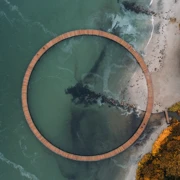Governance For What’s Next 2: Balancing Design
Today more than ever, boards and committees need even-handed architects. How can boards dive into complexity without drowning? How to deal with new questions surrounding diversity, technical literacy and M&A strategy? And how can board design mitigate the personal risk faced by overloaded NEDs?
In this series, Amrop Partners and members of Amrop's Board Services Practice deliver insights from the frontlines of boardrooms.
What pitfalls do governance designers risk in the current climate, and how can they be avoided?

8 insights for balanced board design
- Resist the panic room. Balance risk-averse members with innovative thinkers. Over-protectiveness can harm growth.
- Take a ‘+1’ approach. An odd number of NEDs protects against deadlock. The Chair acts as tiebreaker.
- Rethink your NED profiling. There is still an unconscious selection bias towards male-dominated NED profiles.
- Consider NED neurodiversity. Holistic diversity is quietly replacing quotas. This can protect against ‘groupthink.
- Consider tech-savviness as a form of NED protection: AI and cybersecurity are increasing NED’s risk exposure.
- Integrate 3 routes to board tech capability. Appoint a savvy NED. Create a Tech & Innovation Committee. Educate via briefings, external speakers and immersion sessions.
- Install the 3 core committees. Audit, Compensation (or Remuneration) & Nominating/Governance remain essential
- Base new committees on topics’ lifespan and reach. Is the topic your core business, systemic, or a shift (digital rollout, changes in operating model/expansion)?
Board Composition
The big design lines
A day in the boardroom should be inspiring; one of positive confrontation, stimulated by diversity of demographics and thought. Whilst this is true of today’s best boards, others have a road to travel. This is unsurprising: boards remain human constructs — vulnerable to bias and groupthink, stress and stale paradigms. Unconventional perspectives protect boards from the thinking shortcuts that not only compromise their decisions, but their very composition.
A good independent advisor raises core design questions regarding board culture, strategy and roles, says an Amrop Board Member.

But boards are often unclear on what that strategy is. Another warns that over-protection risks harming growth. Boards must balance conservative, risk-averse members with innovators. “You must be very careful that your entire board is not defensive.”
Safety in numbers
Boards should maintain a majority of NEDs, alongside the CEO and CFO. But how big should your board be? An Amrop Board Member prescribes an odd number of members to safeguard against deadlock. 4+1 or 6+1 models suit smaller businesses, he says. The Chair can act as a tiebreaker where necessary. What if business complexity demands more perspectives? “You can use experts as consultants,” says this Amrop Partner. “Sometimes boards want to find everything in a new board member, and that isn’t the right approach.”
Brilliant women
As debates swirl around the demographics of DEI, gender diversity is facing interrogation. Amrop Partners agree that quotas should never trump meritocracy. Recently, two female NED candidates told an Amrop Partner that gender was their UVP. “I informed both that I never had a client who appointed an incompetent woman over a competent man.” Selection on the pure basis of gender is “dangerous for the company and uncomfortable for the woman.”
But companies seeking brilliant board-ready women face legacy problems, says this Amrop Partner: male-biased profile design, historic imbalances in the top echelons of business, and women’s educational choices. A process of natural (or perhaps unnatural) selection is at play. For example, in the construction industry: “I see personality traits that make women suitable for those roles, that’s why they were appointed. But they may have adjusted to a ‘male’ industry, forced to become stricter and more confrontational than some men.” Executive search consultants must question the competencies asked for, she says.
A push and pull dynamic is at play. Even if some companies and their subsidiaries in Europe and Asia are resisting the global movement against gender diversity, the American subsidiaries of others have stalled their policy, says an Amrop Board Member from the Asia Pacific. Nonetheless, an Amrop Partner from the Nordics believes that gender diversity, at least, will remain a strong aspiration. “It is now seen as both a governance issue and a competitiveness enabler.” For female board members to get a proper hearing, an inclusive culture is vital: “Ensuring airtime, psychological safety, and not overloading them with the ‘ESG seat’ or stereotypical roles.”
Holistic diversity
Post-Covid, an Amrop Board Member proposes a new face of DEI. “Like a PowerPoint color wheel, I don't believe in ‘atypical’. When you meet someone who thinks differently, you say, that's so interesting. I never thought of that.” Neurodiversity is one antidote to groupthink. “You want both ends of the thought spectrum. The Chair’s role is to surface the opinions, encourage an awareness of the risks inherent in different perspectives.” Rather than being entangled in quotas: “we try to provide a business with a room of perspectives in tension with each other, chaired by an individual who allows the voices to be heard and balanced. Holistic diversity is the answer.”
“Diversity is not a fix in itself—it’s a source of potential,” concludes an Amrop Partner. To be realized, it requires “inclusion, structure, and shared purpose.”
Asleep at the wheel?
To maintain their vital objectivity, how long should NED tenure last? After two 3-year mandates “a good independent director will automatically retire from the board and go to another one,” says an Amrop Partner. Another thinks tenure should be lifecycle-dependent. “A company can be on a journey where it has acquired other companies. And it’s somewhere totally different today.” In that case a longstanding ‘go-to’ member is important, if anchoring bias (based on past experience) is not allowed to close minds: “I’ve been around the block a few times, and this won’t work.”
Technical questions
Achieving a diverse yet compact board is tricky. How can boards improve technical oversight without over-stretching their existing NEDs, or taking on more? One Amrop Partner notes that literacy will not only protect the business, but the board, especially as AI is increasing NED risk exposure. “You don’t know what you don’t know, so you need a trusted board member. One with professional expertise, who can explain and help you make an educated judgment.” Thanks to this trust and understanding, “you can take your responsibility to sign.”
A 3-point solution for tech governance
- Unpack the problem. Ask: is technology your core business, systemic within it, or a ring-fenced shift? Devote a 2-day session to a deep dive, involving executive teams.
- Create tech ‘buckets’. Each should be overseen by a board member with the right behavioral type (creative or prudent). Then build executive task forces to support understanding.
- Take an elevated view. Assess the role of tech across your market. Examine competitor activity and approach, products. Conduct autopsies and postmortems.
An Amrop Board Member warns boards against delegating tech responsibility to an expert. Nor will technical expertise solve the philosophical questions raised by AI or address its multi-faceted business impact. “It’s not just technical — it’s ethical,” says one Amrop Partner. “It should be one of our hottest topics, on the same level as finance.” Integrated solutions are the name of the game.
“Diversity is not a fix in itself — it’s a source of potential."
Committees
“Most boards still need the classic three committees—regardless of sector or ownership model,” says this Amrop Partner.
- Audit, for financial integrity, controls, risk oversight, and ESG assurance.
- Compensation (or Remuneration) for pay, incentives, and alignment with long-term value.
- Nominating and Governance for board composition, succession, evaluation, and governance.
What of a Nomination Committee? “Boards are not good at looking at their own succession — it’s too close to home,” says this Amrop Partner. “A separate Nominating Committee is a good system. The Board Chair is often a member.”
Can committees be combined? Nominations, Governance and Risk may form one body (dependent upon a company’s listing status). Risk should be split off if the business is especially exposed (in financial services and energy, for example). “I’m seeing a trend in some markets towards a single Nominations and Remuneration Committee, and in others, a separate Remuneration Committee,” says an Amrop Board Member. He sees remuneration as the “Achilles heel for activist shareholders.” When frameworks are shot down at AGMs, “everything collapses, because the CEO says, “what am I going to get paid? What’s going on with my short-term incentive? Do I get my share scheme?”
Planning for what’s next
ESG, AI, CSRD, DEI…Do they deserve dedicated committees? Technical (or even AI) committees can compensate for board shortfalls and shore up oversight. To determine the need, Amrop Board Member has three check questions for boards: is technology your business, systemic, or a shift? A mobile phone company argues that their business is intrinsically technological. “Why would we have a ring-fenced Tech Committee?” But agricultural company might need a committee to address the innovative portion of its business. “Unless you highlight it, you’re not going to get action.” 
An Amrop Partner observes the creation of Transformation or Strategy Committees “during major shifts—digital rollouts, changes in the operating model, market expansions. “Meanwhile, in The Great Reset’ Amrop Partners report a pendulum swing away from responsible business. Nonetheless, Sustainability and ESG committees are on the rise in sectors under pressure from regulation, investors, and public opinion.
Investment committees are a further option, says an Amrop Board Member, as companies transit between centralization and decentralization, divestment and growth, and embark upon M&As. “They perform the due diligence, recommend what to pay and how to manage it on the balance sheet.”
What profiles should populate such committees? “On the Investco or Tech Committee I’m after futurists,” he says. With a chair playing a balancing role, “you should get high quality decisions.”
Temporary solutions
Could temporary committees support agility? Opinions differ. “A committee should be established within the governance framework if there’s a systemic need,” says an Amrop Board Member. “But a one-off flag such as implementing SAP globally can be facilitated and managed by the Audit and Risk Committee.”
Beyond digital or operational transformations, ad hoc committees can support crisis management, major M&A or divestitures, regulatory investigations or ESG controversies, says an Amrop Partner. “They allow a small group of board members to deep-dive into an issue, often with external support, without overloading the full board or standing committees. The key is to define their scope clearly, sunset them when appropriate, and maintain transparency with the full board.”
A material change to the business is another story. When transformation plays a fundamental role to future-proof a business, a temporary committee will not cut it.
Amrop contributors
Naohiro Furuta, Japan
Kenneth V. Mortensen, Denmark
Gabriela Nguyen-Groza, Luxembourg
Adam Saunders, UK
Andrew Woodburn, South Africa
Elin Wrammerfors, Sweden